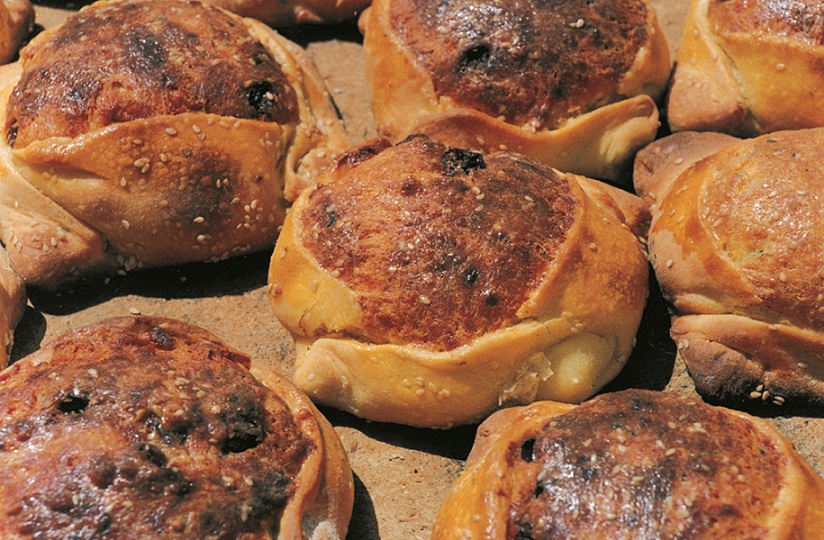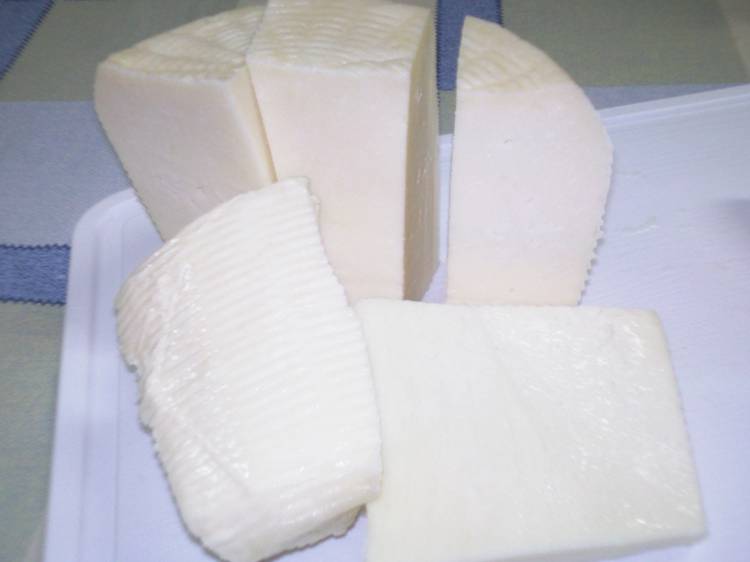Shepherds used to place branches of louvithkia (xistarka) in the milk strainer as its leaves had a sticky juice with a very delicate smell.
Name - Origin
Ακαθιώτικο τυρί. It was made in the community of Akanthous from fresh goat's milk obtained from animals grazing freely in open areas with a variety of aromatic plants
The cheese got its name from its village of origin: the village of Akanthous (note: Stalo Lazarou).
Goat's milk was placed in a cauldron ("hartžín") which was boiled on the "niskia". Rennet was added and the milk was curdled; this was followed by cutting and stirring the curd ('vloúgos'). Then, 'vlougos' was placed in talaria (woven baskets) and pressed firmly by hand. Talaria were then placed in the boiling whey (first boil). The cheese was removed from talaria and, after it had been rubbed to become shiny, it was turned over in the talaria and pressed again. The cheese was then placed back in the hot whey (second boil). The cheese was then removed from the talaria, salted and placed back in the talaria, a process that would be repeated for the next 2-3 days. Finally, the cheese was removed from the talaria and left outside for 3-4 nights to allow it to 'absorb' the humidity of the night. It was then either placed in a 'psatharká' (woven reed) over smoke from s̆innos plant (pistacia lentiscus) in order to be smoked or it was immersed in melted wax (Economides, 2004).
Shepherds used to place branches of louvithkia (xistarka) plant in the milk strainer, as its leaves had a sticky juice with a very delicate smell. As a result, the foreign bodies in the milk would stick to the leaves of the plant, while at the same time the milk would acquire the special aroma of the plant (Ioannidou 2009).
Functional and symbolic role
Akathiotiko cheese was used for the preparation of flaounes, as a snack or as a grated cheese over pasta.
Akathiotiko cheese was made during the 50-day period before Easter and was exported to the neighbouring countries of Cyprus. It was used in the preparation of flaounes.
Additional information and bibliography
The production of Akathkiotiko cheese is mentioned in written sources of the 18th and 19th century: ''Many excellent cheeses from the villages of Akanthous and Kefalon, and from some villages of Paphos'' (Archim. Kyprianos, 1788). In 1890, Sakellarios mentions: 'And the cheese of Akanthous is the best on the island'.
Akathkiotiko cheese was known for its good quality which, according to P. Pantelidis (1984, 191), was due to the various aromatic plants that could be found in the mountainous areas and were the food of the animals. The shepherds - dairy farmers of Akanthous used to put branches of "μαύρη λεουθκιά" (black leouthkiá plant) in the strainer of the milk they would use to make cheese. This type of leouthkia plant has a sticky juice with a very delicate smell, called leóni. So they would use the leouthkia branches for two reasons: firstly, the impurities in the milk would stick to the leouthkia leaves, and secondly, the milk would acquire the delicate scent of the plant.
Economides, S. (2004)Το γάλα και τα γαλακτοκομικά προϊόντα της Κύπρου με ιδιαίτερη αναφορά στο τυρί χαλλούμι, Cyprus Dairy Industry Organisation, Nicosia.
Pantelides P. (1984). Ακανθού. Εκεί που σμίγουν θρύλοι και ιστορία, [χ.ό.], Nicosia.
Ministry of Agriculture, Natural Resources and Environment, Department of Agriculture (2010). Gastronomic Map of Cyprus, Press and Information Office (P.I.O. 379/2010-2.000), Nicosia.
Stalo Lazarou


